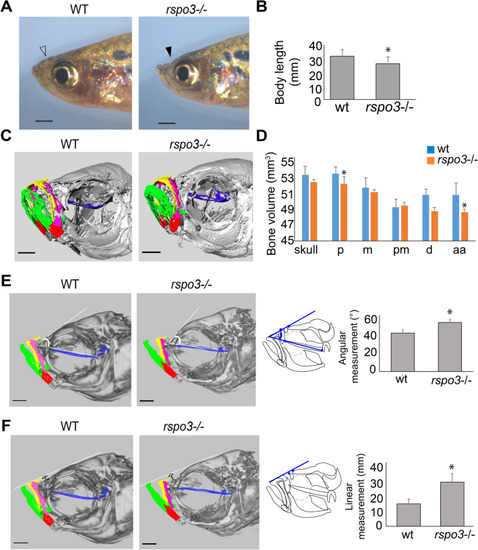
rspo3 mutants exhibited midface deficiency, frontal bossing and decreased body length. Reduced body length, midface deficiency and frontal bossing were observed in adult rspo3−/− (180 dpf). (A) Lateral image of adult zebrafish showing midface depression in rspo3−/− (solid arrow) compared to wild-type (open arrow). (B) Body length was significantly decreased in rspo3−/− mutants relative to wild-type. (C) Oblique micro-CT image of rspo3−/− and wild-type fish at 180 dpf. Individual bone elements are color coded (blue: parashenoid, pink: maxilla, yellow: premaxilla, green: dentary and red: anguloarticular). Scale bar: 10 μm. (D) Bone volume of the skull and of specific bones in rspo3−/− and wild-type individuals demonstrates element-specific differences in volume. Parasphenoid and anguloarticular bone volume were significantly reduced in rspo3−/− compared to wild-type fish. Abbreviations: aa: anguloarticular, d: dentary, m: maxilla, p: parasphenoid, pm: premaxilla. (E) 2D cephalometric analysis obtained from micro-CT of rspo3−/− and wild-type fish. The angle formed by parasphenoid line and a line tangent to frontal bone identified frontal bossing, with increased angle in rspo3−/− compared to wild-type. Diagram of lateral view of adult zebrafish showing the angular measurement. Bar chart showing statistical differences in the angular measurement between rspo3−/− and wild-type. (F) 2D cephalometric analysis of rspo3−/− and wild-type fish. The distance between nasal bone and a line drawn between dentary and frontal bone landmarks were measured. Diagram of lateral view of adult zebrafish showing the linear measurement from nasal bone to a line tangent to the frontal bone and dentary. The linear measurement value was significantly greater in rspo3−/− mutants than in wild-type indicating the presence of midface hypoplasia. *p ≤ 0.05. Scale bar: 100 μm.
|

